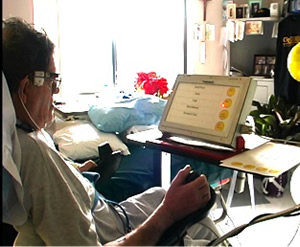You are viewing the website for the aac-rerc, which was funded by NIDRR from 2008-2013.
For information on the new RERC on AAC, funded by NIDILRR from 2014-2019, please visit rerc-aac.psu.edu.
Improved AAC Interface Strategies for Limited/Uncontrolled Movements
Tom Jakobs (InvoTek, Inc.)
Challenge:
This project seeks to investigate new techniques for making AAC devices easier and more efficient to use, especially for people that presently have few AAC choices. These people often have substantial needs and a confounding array of physical and cognitive abilities that require an optimized and intuitive user interface.

Goals:
• Identify new interface strategies for use by people with severe movement limitations
• Prepare design specifications for innovative access techniques
• Investigate the impact of new alternate interface strategies
Planned Activities:
• Identify and investigate new AAC interfaces that users find intuitive and that require little effort and skill to setup.
• Investigate combining multiple access methods into a single, efficient control strategy.
• Identify and investigate new techniques for entering information into computers that don’t require precise control.
Annual Update (May, 2011)
Design specifications and prototypes have been developed for several new interface prototypes:
• The GestureTouch interface reduces the reliance on the “dwell” feature to access mouse controlled interfaces. Rather, words are accessed by making a continuous touch movement that approximates the first two or three letters of word and the language model completes the word. Data has been collected on typical adult participants as well as those with limited hand movement due to spinal cord injury. Ongoing data collection involves people for whom the motor control for “dwell” is difficult.
• The prototype for a laser control speech button is nearly complete. A safe–laser pointer can be used to access the “button” which can be attached to an object or picture. Upon activation, the button will speak a pre- programmed message or simply provide environmental control.
• An off-screen keyboard that can be positioned to the side or below a computer screen has been developed and evaluated. The keyboard is controlled by the AccuPoint system using head control.
Knowledge Transfer
Fager, S., Beukelman, D., & Jakobs, T. (June, 2009). Supporting Communication of Individuals with Minimal Movement. Presentation at the Annual Conference of the Rehabilitation Engineers Society of North America, New Orleans, LA. (handout)
Fager, S., & Jakobs, T. (November, 2009). State of the Art Technology for People with Minimal Movement Ability. Presentation at World Congress on Disabilities, Jacksonville, FL. (handout)
Fager, S. & Beukelman, D. (2010). Supporting Communication of Individuals with Minimal Movement. (webcast)
Fager, S. & Beukelman, D. (2010). Supporting Communication of Individuals with Minimal Movement. (YouTube clip)